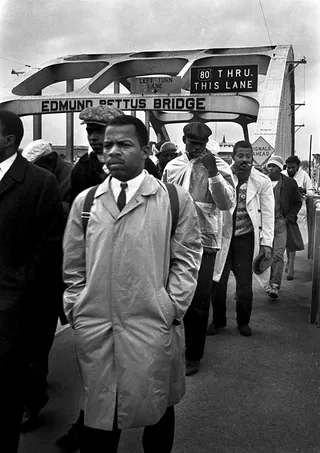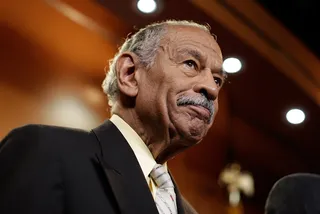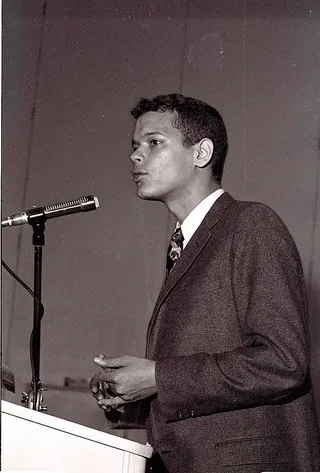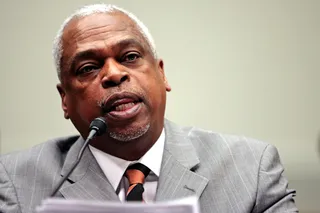The March on Washington: Then and Now
Leaders recall the original March on Washington.

1 / 12
You Had to Be There - Back in 1963, thousands of African-Americans were determined to attend the March on Washington by any means necessary. Read here to learn what the day was like for some of the young people who eventually became leaders and a few thoughts on the work yet to be done. —Joyce Jones (Photo:AFP/Getty Images)

2 / 12
Rep. John Lewis (Georgia) - I was deeply moved to see that sea of humanity. Individuals wanted to get as close to the Lincoln Memorial as possible, but it was impossible because there were so many people. Back in 1963, there were more trees on the [National] Mall. And many of the young men, black and white, got up in the trees to get a better view of the podium. And when I got there, and I turned and looked back, it was just amazing to see the crowd. (Photo: David McNew/Getty Images)

3 / 12
Rep. John Lewis (Georgia) - [Martin Luther King Jr.] would be very pleased with the large number of minority elected officials and that we have a person of color as president. But he'd be disappointed that we still engage in war and spend billions on weapons that destroy rather than on efforts to clothe, feed, educate and house our people. (Photo: Birmingham News /Landov)
Photo By Birmingham News /Landov

4 / 12
Rep. John Conyers (Michigan) - The March on Washington was a watershed moment in American history that became a turning point in the civil rights movement. It was a defining point in my life to march alongside thousands of individuals, with no common background, all coming together for the unifying vision of jobs, justice and peace. (Photo: Mark Wilson/Getty Images)

5 / 12
Rep. John Conyers (Michigan) - In the five decades following Dr. Martin Luther King, Jr.’s declaration of the dream, the United States stands at a crossroads. We live in a society where racial discrimination remains an ongoing problem in terms of education, economic opportunity and redlining, racial profiling and disparate treatment by law enforcement as well as threats to voting rights. While we are appreciative of the past, the struggle for full equality continues. (Photo: Win McNamee/Getty Images)
Photo By Win McNamee/Getty Images
ADVERTISEMENT

6 / 12
Rep. G.K. Butterfield (North Carolina) - I was there, just 16 years old. It was hot as hell and I'd never seen that many white people demonstrating for rights for African-Americans. Those are the two things that stand out in my mind. It was a momentous occasion and changed the direction of the civil rights conversation. It was a defining moment. (Photo: Chuck Liddy/Raleigh News & Observer/ MCT /LANDOV)
![Rep. Charles Rangel (New York) - I have never in my entire life seen my community in Harlem acting like their lives depended on [attending the march]. I've seen so much, but to see little kids and old folks saying, "See you in Washington!" even though they didn't know how they'd get there. I'm looking at these old people and guess what: they were there! The unions had vehicles and said, "If you don't know how you're going to get there, meet us on 25th Street and 7th Avenue." (Photo: Dennis Brack /Landov)](https://images.paramount.tech/uri/mgid:arc:imageassetref:bet.com:ae35a36b-2948-420c-a922-c588f82ed8b6?format=webp&width=320)
7 / 12
Rep. Charles Rangel (New York) - I have never in my entire life seen my community in Harlem acting like their lives depended on [attending the march]. I've seen so much, but to see little kids and old folks saying, "See you in Washington!" even though they didn't know how they'd get there. I'm looking at these old people and guess what: they were there! The unions had vehicles and said, "If you don't know how you're going to get there, meet us on 25th Street and 7th Avenue." (Photo: Dennis Brack /Landov)

8 / 12
Julian Bond - I was up front by the speakers' platform and could look back and see the people but had no idea how many were there. When I read the newspapers the next day and saw their estimates I realized I had been to something fantastic that probably would not be duplicated again. (Photo: Richard Sheinwald /Landov)
Photo By Photo: Richard Sheinwald /Landov

9 / 12
Rep. Charles Rangel (New York) - It was so exciting. I had no idea as the Southerners did the impact that these national events would really have. I tell John Lewis all the time that he and Dr. King truly believed and I didn't. I marched from Selma to Montgomery, 54 miles, and I cussed every step of the way, wondering what the hell I was doing. It has been 50 years and we've got a whole lot of roads, a whole lot of marches that we still have to do. (Photo: Michael Loccisano/Getty Images)
![Rep. Eleanor Holmes Norton (District of Columbia) - We always anticipated it would be big, but we had no idea what big really meant. We couldn’t say "as big as..." because there was no as. [Eleanor Holmes Norton assisted civil rights leaders in planning the march.] (Photo: Barbara L. Salisbury/The Washington Times /Landov)](https://images.paramount.tech/uri/mgid:arc:imageassetref:bet.com:ae35a36b-2948-420c-a922-c588f82ed8b6?format=webp&width=320)
10 / 12
Rep. Eleanor Holmes Norton (District of Columbia) - We always anticipated it would be big, but we had no idea what big really meant. We couldn’t say "as big as..." because there was no as. [Eleanor Holmes Norton assisted civil rights leaders in planning the march.] (Photo: Barbara L. Salisbury/The Washington Times /Landov)
ADVERTISEMENT

11 / 12
Julian Bond - We need a renewed commitment to making King's dream come true. We have to register more voters, make sure more people vote, join in coalitions with other people who share our values, engage in litigation and keep pushing, and pushing and pushing. (Photo: Brian Ach/Getty Images for People for the American Way Foundation)
